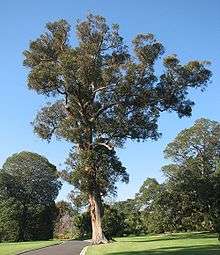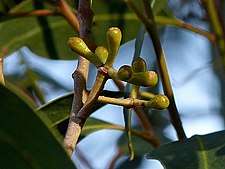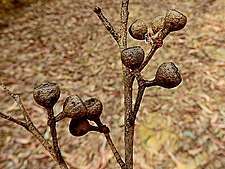Eucalyptus muelleriana
Eucalyptus muelleriana, commonly known as yellow stringybark,[2] is a species of medium-sized to tall tree that is endemic to southeastern Australia. It has rough, stingy bark on the trunk and branches, lance-shaped to curved adult leaves, flower buds in groups of between seven and eleven, white flowers and cup-shaped to shortened spherical fruit.
| Yellow stringybark | |
|---|---|
 | |
| Eucalyptus muelleriana in the Royal Botanic Garden, Melbourne | |
| Scientific classification | |
| Kingdom: | Plantae |
| Clade: | Tracheophytes |
| Clade: | Angiosperms |
| Clade: | Eudicots |
| Clade: | Rosids |
| Order: | Myrtales |
| Family: | Myrtaceae |
| Genus: | Eucalyptus |
| Species: | E. muelleriana |
| Binomial name | |
| Eucalyptus muelleriana | |
| Synonyms[1] | |
| |


Description
Eucalyptus muelleriana is a tree that typically grows to a height of 40 m (130 ft) and forms a lignotuber. It has rough, stringy, greyish bark from the base of the trunk to the thinnest branches. Young plants and coppice regrowth have lance-shaped leaves that are glossy dark green on the upper surface, paler below, 55–135 mm (2.2–5.3 in) long, 10–50 mm (0.39–1.97 in) wide and petiolate. Adult leaves are lance-shaped to curved, glossy green but slightly paler on the lower surface, 80–200 mm (3.1–7.9 in) long and 14–45 mm (0.55–1.77 in) wide on a petiole 5–20 mm (0.20–0.79 in) long. The flower buds are arranged in leaf axils in groups of seven, nine or eleven on an unbranched peduncle 5–20 mm (0.20–0.79 in) long, the individual buds on pedicels 2–5 mm (0.079–0.197 in) long. Mature buds are oval, 5–7 mm (0.20–0.28 in) long and 3–4 mm (0.12–0.16 in) wide with a conical to rounded operculum. Flowering occurs between January and May and the flowers are white. The fruit is a woody, cup-shortened to shortened spherical capsule 6–10 mm (0.24–0.39 in) long and 7–12 mm (0.28–0.47 in) wide with the valves level with the rim or slightly protruding.[2][3][4][5]
Taxonomy and naming
Eucalyptus muelleriana was first formally described in 1891 by Alfred William Howitt in Transactions of the Royal Society of Victoria.[6][7] The specific epithet honours Ferdinand von Mueller.[2]
Distribution and habitat
Yellow stringbark grows in wet forests on coastal plains, ranges and escarpments from Wollongong in New South Wales to Wilsons Promontory in Victoria.[3][4][5] It has also been planted in New Zealand. [8][9]
Uses
Yellow stringbark provides a valuable timber which is strong, durable, straight-grained and has been widely used, particularly in Victoria for posts and piles. [8][9]
See also
References
- "Eucalyptus muelleriana". Australian Plant Census. Retrieved 11 November 2019.
- "Eucalyptus muelleriana". Euclid: Centre for Australian National Biodiversity Research. Retrieved 31 May 2020.
- Brooker, M. Ian H.; Slee, Andrew V. "Eucalyptus muelleriana". Royal Botanic Gardens, Victoria.
- Chippendale, George M. "Eucalyptus muelleriana". Australian Biological Resources Study, Department of the Environment and Energy, Canberra. Retrieved 11 November 2019.
- Hill, Ken. "Eucalyptus muelleriana". Royal Botanic Garden Sydney. Retrieved 11 November 2019.
- "Eucalyptus mulleriana". Australian Plant Name Index. Retrieved 11 November 2019.
- Howitt, Alfred W. (1891). "The Eucalypts of Gippsland". Transactions of the Royal Society of Victoria. 2 (1): 89–91. Retrieved 11 November 2019.
- Kelly, Stan. (1969). Eucalypts. Chippendale, George McCartney., Johnston, R. D. [Melbourne]: Nelson. ISBN 0-17-001861-X. OCLC 80440.
- "NZ Farm Forestry - NZFFA Guide Sheet No. 3: Eucalypts for Timber". www.nzffa.org.nz. Retrieved 2020-07-15.